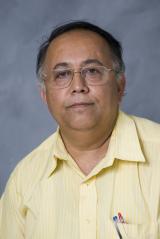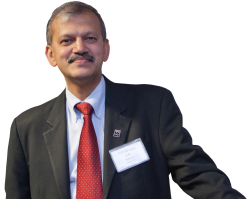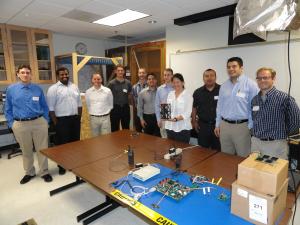 Last year, Somnath Chattopadhyay, a faculty member in electrical and computer engineering, received a three-year grant from the Department of Defense Army Research Office to develop an optically controlled silicon carbide/gallium nitride–based MESFET (metal semiconductor field effect transistor). The device, which will control the actuators in an airplane’s onboard power system with UV light rather than electrically, has several advantages: the system won’t be disrupted by radiofrequency or electromagnetic fields; it will potentially lighten aircraft by 30%; and it will not be vulnerable to radiation at high altitudes or to temperature extremes, which can also interfere with signals.
Last year, Somnath Chattopadhyay, a faculty member in electrical and computer engineering, received a three-year grant from the Department of Defense Army Research Office to develop an optically controlled silicon carbide/gallium nitride–based MESFET (metal semiconductor field effect transistor). The device, which will control the actuators in an airplane’s onboard power system with UV light rather than electrically, has several advantages: the system won’t be disrupted by radiofrequency or electromagnetic fields; it will potentially lighten aircraft by 30%; and it will not be vulnerable to radiation at high altitudes or to temperature extremes, which can also interfere with signals.
In the intervening months, Chattopadhyay has determined that gallium nitride is the more promising material for the device and plans to switch over to using it exclusively for the MESFET. He hopes to acquire metal organic chemical vapor deposition (MOCVD) equipment to grow the gallium nitride in house, which will diversify research in optoelectronic and electronic devices; gallium nitride is very expensive to buy, and the MOCVD equipment will allow him to control the quality of the wafers at his disposal. He has also modeled the MESFET device and process technology using Synopsys TCAD software, although because the technology is novel and no one has used it before, the modeling has thus far only yielded electrical characteristics, not those of the optical signal.
While he continues to make progress on the SiC/GaN based MESFET, which will be handed over to Boeing at the end of the project for further testing and qualification, Chattopadhyay is already looking ahead to other applications for his technology. These include high-frequency telecommunications and monitoring temperature in jet engines and other extreme environments.
“We believe we’re the first group who are developing such a transistor,” he says, “and this will give us a very wide band of research opportunity.”
A message from the Dean
February 6, 2014Industry partnerships – HAAS
February 6, 2014Industry Partnerships – Jet Propulsion Laboratory
February 6, 2014
Leave a reply Cancel reply
-
Welcome New Faculty
January 20, 2021 -
2015 San Fernando Valley Engineers’ Council College Awardees
March 25, 2016 -
CECS Students Shine in Solar Project
June 16, 2010



